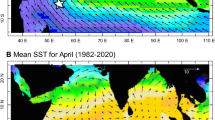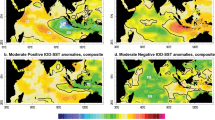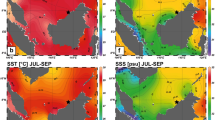Abstract
The El Niño/Southern Oscillation (ENSO) system during the Pliocene warm period (PWP; 3–5 million years ago) may have existed in a permanent El Niño state with a sharply reduced zonal sea surface temperature (SST) gradient in the equatorial Pacific Ocean1. This suggests that during the PWP, when global mean temperatures and atmospheric carbon dioxide concentrations were similar to those projected for near-term climate change2, ENSO variability—and related global climate teleconnections—could have been radically different from that today. Yet, owing to a lack of observational evidence on seasonal and interannual SST variability from crucial low-latitude sites, this fundamental climate characteristic of the PWP remains controversial1,3,4,5,6,7,8,9,10. Here we show that permanent El Niño conditions did not exist during the PWP. Our spectral analysis of the δ18O SST and salinity proxy, extracted from two 35-year, monthly resolved PWP Porites corals in the Philippines, reveals variability that is similar to present ENSO variation. Although our fossil corals cannot be directly compared with modern ENSO records, two lines of evidence suggest that Philippine corals are appropriate ENSO proxies. First, δ18O anomalies from a nearby live Porites coral are correlated with modern records of ENSO variability. Second, negative-δ18O events in the fossil corals closely resemble the decreases in δ18O seen in the live coral during El Niño events. Prior research advocating a permanent El Niño state may have been limited by the coarse resolution of many SST proxies, whereas our coral-based analysis identifies climate variability at the temporal scale required to resolve ENSO structure firmly.
This is a preview of subscription content, access via your institution
Access options
Subscribe to this journal
Receive 51 print issues and online access
$199.00 per year
only $3.90 per issue
Buy this article
- Purchase on Springer Link
- Instant access to full article PDF
Prices may be subject to local taxes which are calculated during checkout



Similar content being viewed by others
References
Wara, M. W., Ravelo, A. C. & Delaney, M. L. Permanent El Niño-like conditions during the Pliocene warm period. Science 309, 758–761 (2005)
Mix, A. C. et al. Benthic foraminiferal stable isotope record from Site 849, 0–5 Ma: local and global climate changes. Proc. ODP Sci. Res. 138, 371–412 (1995)
Molnar, P. & Cane, M. A. El Niño’s tropical climate and teleconnections as a blueprint for pre-Ice Age climates. Paleoceanography 17, 1021 (2002)
Ravelo, A. C., Andreasen, D. H., Lyle, M., Lyle, A. O. & Wara, M. W. Regional climate shifts caused by gradual global cooling in the Pliocene epoch. Nature 429, 263–267 (2004)
Rickaby, R. E. M. & Halloran, A. P. Cool La Niña during the warmth of the Pliocene? Science 307, 1948–1952 (2005)
Fedorov, A. V. et al. The Pliocene paradox (mechanisms for a permanent El Niño). Science 312, 1485–1489 (2006)
Haywood, A. M., Valdes, P. J. & Peck, V. L. A permanent El Niño-like state during the Pliocene? Paleoceanography 22, PA1213 (2007)
Molnar, P. & Cane, M. A. Early Pliocene (pre-Ice Age) El Niño-like global climate: which El Niño? Geosphere 3, 337–365 (2007)
Lawrence, K. T., Liu, Z. & Herbert, T. D. Evolution of the eastern tropical Pacific through Plio-Pleistocene glaciation. Science 312, 79–83 (2006)
Dowsett, H. J. & Robinson, M. M. Mid-Pliocene equatorial Pacific sea surface temperature reconstruction: a multi-proxy perspective. Phil. Trans. R. Soc. A 367, 109–125 (2009)
Philander, S. G. H. El Niño, La Niña and the Southern Oscillation 9–57 (Academic, 1990)
Cole, J. E., Fairbanks, R. G. & Shen, G. T. Recent variability in the southern oscillation: isotopic results from Tarawa Atoll coral. Science 260, 1790–1793 (1993)
Corrège, T. et al. Interdecadal variation in the extent of South Pacific tropical waters during the Younger Dryas event. Nature 428, 927–929 (2004)
Tudhope, A. W. et al. Variation in the El Niño-Southern Oscillation through a glacial-interglacial cycle. Science 291, 1511–1517 (2001)
Watanabe, T. et al. Oxygen isotope systematics in Diploastrea heliopora: new coral archive of tropical paleoclimate. Geochim. Cosmochim. Acta 67, 1349–1358 (2003)
Rasmusson, E. M. &. Carpenter, T. H. Variations in tropical sea surface temperature and surface wind fields associated with the Southern Oscillation/El Niño. Mon. Weath. Rev. 110, 354–384 (1982)
Ropelewski, C. F. & Halpert, M. S. Global and regional scale precipitation patterns associated with the El Niño/Southern Oscillation. Mon. Weath. Rev. 115, 1606–1626 (1987)
Dai, A. & Wigley, T. M. L. Global patterns of ENSO-induced precipitation. Geophys. Res. Lett. 27, 1283–1286 (2000)
Raffi, I. et al. A review of calcareous nannofossil astrobiochronology encompassing the past 25 million years. Quat. Sci. Rev. 25, 3113–3137 (2006)
Cobb, K. M. Charles, C. D. Cheng, H. & Edwards, R. L. El Niño/Southern oscillation and tropical Pacific climate during the last millennium. Nature 424, 271–276 (2003)
Urban, F. E., Cole, J. E. & Overpeck, J. T. Influence of mean climate change on climate variability from a 155-year tropical Pacific coral record. Nature 407, 989–993 (2000)
Fedorov, A. V., Brierley, C. M. & Emanuel, K. Tropical cyclones and permanent El Niño in the early Pliocene epoch. Nature 463, 1066–1070 (2010)
Reynolds, R. et al. Daily high-resolution blended analyses for sea surface temperature. J. Clim. 20, 5473–5496 (2007)
Acknowledgements
We would like to thank H. H. Ramos for a research permit and W. Mago and E. Azurin for their help with fieldwork. Special thanks go to F. P. Siringan for the study of modern coral; H. Nomura and K. Nakamura for preparing thin sections; R. Miyawaki for assistance with X-ray diffraction; S. Motai, Y. Seto and K. Omori for their assistance with synchrotron X-ray diffraction; C. Shimada, M. Ikeda and K. Hagino-Tomioka for their scanning electron microscopy observations; Y. Yoshinaga for microsampling; and A. Yamazaki for preparing the figures.
Author information
Authors and Affiliations
Contributions
T.W., A.S. and T. Kase designed the research. T. Kawashima and K.M. performed isotopic analysis under the supervision of T.W., A.S. and H.K. S.M. performed statistical analysis and climatology. K.K. observed nannofossil assemblages. T.W., T. Kawashima, Y.M.A., R.W. and K.S. carried out the field survey under the supervision of T. Kase. T.W. and K.S. performed synchrotron X-ray diffraction analysis under the supervision of T.N. T.W. wrote the paper in discussion with all authors.
Corresponding author
Ethics declarations
Competing interests
The authors declare no competing financial interests.
Supplementary information
Supplementary Information
The file contains Supplementary Text, Supplementary References and Supplementary Figures 1-5 with legends. (PDF 3648 kb)
Rights and permissions
About this article
Cite this article
Watanabe, T., Suzuki, A., Minobe, S. et al. Permanent El Niño during the Pliocene warm period not supported by coral evidence. Nature 471, 209–211 (2011). https://doi.org/10.1038/nature09777
Received:
Accepted:
Published:
Issue Date:
DOI: https://doi.org/10.1038/nature09777
This article is cited by
-
Machine learning prediction of connectivity, biodiversity and resilience in the Coral Triangle
Communications Biology (2022)
-
Mid-Pliocene El Niño/Southern Oscillation suppressed by Pacific intertropical convergence zone shift
Nature Geoscience (2022)
-
Changing El Niño–Southern Oscillation in a warming climate
Nature Reviews Earth & Environment (2021)
-
Reduced Atlantic variability in the mid-Pliocene
Climatic Change (2020)
-
The changes in ENSO-induced tropical Pacific precipitation variability in the past warm and cold climates from the EC-Earth simulations
Climate Dynamics (2020)
Comments
By submitting a comment you agree to abide by our Terms and Community Guidelines. If you find something abusive or that does not comply with our terms or guidelines please flag it as inappropriate.



